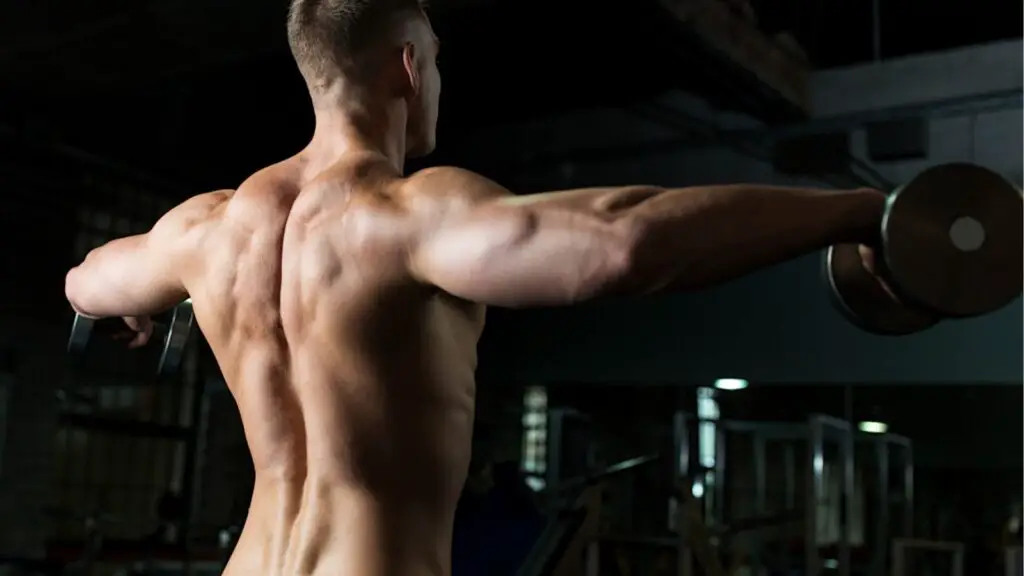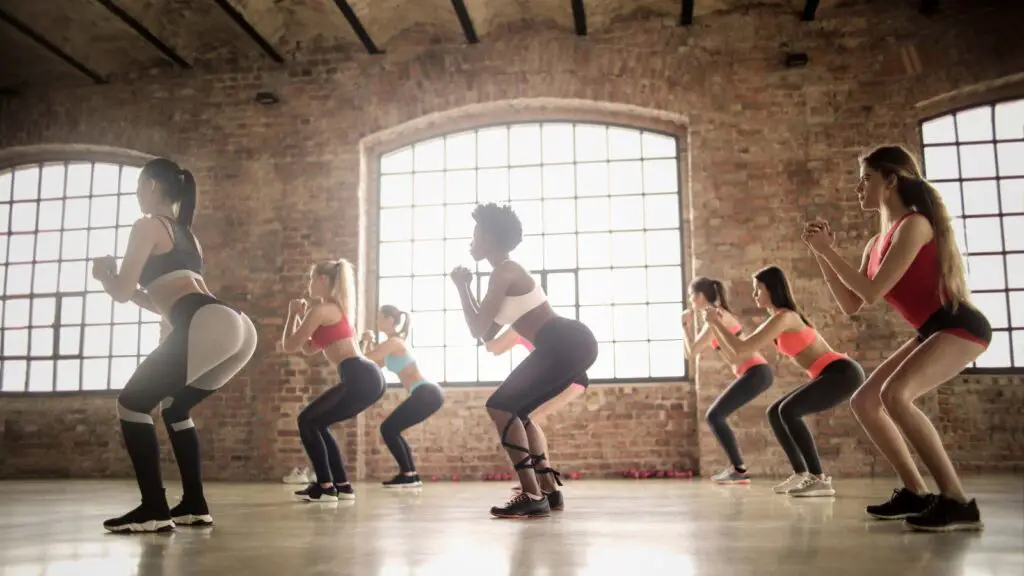Chest dips and tricep dips, two different dips targeting different muscles.
There’s also cheesy dips, creamy dips, spicy dips, but we’re not going to talk about them today.
Dipping back in to the article now, so how effective is each exercise and is there a point in actually doing both?
Chest dips and tricep dips are two bodyweight exercises that can be used as part of your strength training. The chest dip primarily targets the chest muscle, while the tricep dip targets the triceps.
In this article we discuss Chest Dips vs Tricep Dips, highlighting their differences and making it easier for you to understand when and how to do them.
What are the similarities?
Chest dips and tricep dips are both bodyweight exercises that target different muscle groups in the upper body. While they are distinct exercises with different primary muscle focuses, they share some similarities:
- Parallel Bars: Both chest dips and tricep dips require the use of parallel bars or dip bars for support. The bars provide stability and allow for a controlled range of motion.
- Vertical Movement: In both exercises, your body moves vertically up and down. You lower your body down between the bars and then push it back up to the starting position.
- Upper Body Engagement: Chest dips involve the chest muscles (pectorals) and the front part of the shoulders (anterior deltoids), while tricep dips primarily target the triceps (back of the upper arm) and the shoulders.
- Core Engagement: To maintain stability and control during both exercises, your core muscles are engaged to support your body.
- Bodyweight Resistance: Chest dips and tricep dips are bodyweight exercises, which means you are lifting your own body weight. You can adjust the level of resistance by using assistance (e.g., resistance bands) or additional weight (e.g., a weight belt with plates).
- Variations: Both exercises offer variations to target different muscle groups or emphasize specific areas. For example, leaning forward during chest dips can shift the focus more on the chest, while maintaining an upright position places more emphasis on the triceps.
Depending on your fitness goals and which muscle group you want to work, you can choose the appropriate exercise or incorporate both into your upper body workout routine.
What are the differences?
While there are similarities, it’s important to note that the primary target muscles and execution of chest dips and tricep dips differ.
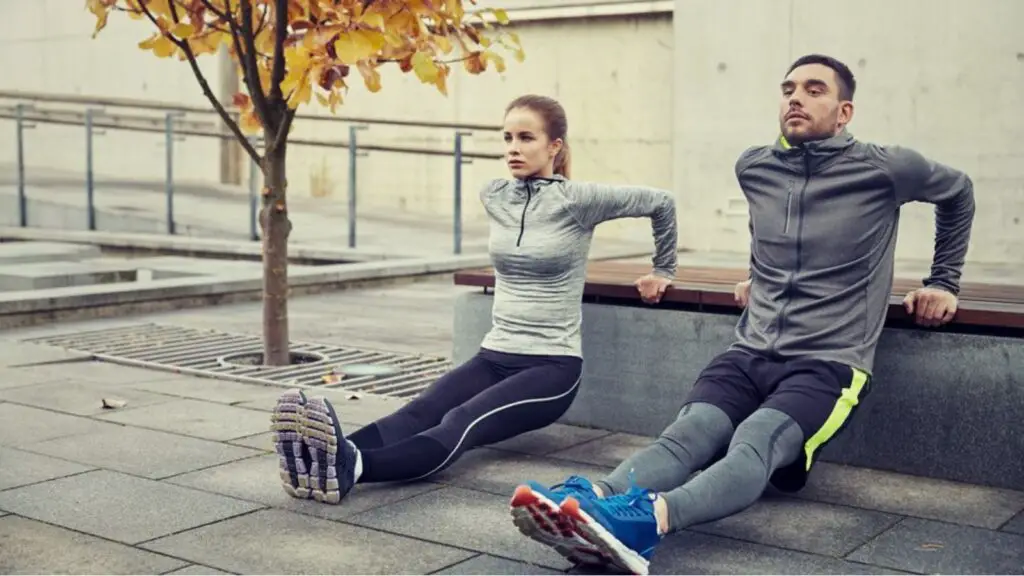
Here are the key differences between the two exercises:
Primary Muscle Focus
- Chest Dips: Chest dips primarily target the pectoral muscles (chest muscles) and the front part of the shoulders (anterior deltoids). They are an effective exercise for building chest strength and size.
- Tricep Dips: Tricep dips primarily target the triceps brachii (the muscles on the back of your upper arm) and the shoulders, particularly the posterior deltoids (back part of the shoulders). They are effective for tricep strength and development.
Body Position
- Chest Dips: During chest dips, you typically lean forward, allowing your torso to incline. This forward-leaning position emphasizes the chest muscles and increases the range of motion for the chest.
- Tricep Dips: Tricep dips typically involve keeping your torso more upright, with a straight or slightly forward lean. This position places less emphasis on the chest and more on the triceps.
Elbow Position
- Chest Dips: In chest dips, your elbows may flare out to the sides as you dip, which can help activate the chest muscles more effectively.
- Tricep Dips: In tricep dips, your elbows tend to stay closer to your body as you dip, which places greater emphasis on the triceps.
Execution
- Chest Dips: To perform chest dips, you lower your body by bending your elbows while leaning forward. Your shoulders should move in front of your hands, and you push your body back up to the starting position.
- Tricep Dips: To perform tricep dips, you lower your body by bending your elbows, keeping them close to your sides. Your shoulders stay above your hands, and you push your body back up to the starting position.
Overall, the main difference between chest dips and tricep dips is their primary muscle focus. The execution and body position for each exercise also differ to optimize muscle engagement in the targeted areas.
Chest dips focus on the chest and anterior deltoids, while tricep dips target the triceps and posterior deltoids (back part of the shoulders).
Target muscle
Here are the main target muscles for each of these exercises:
Chest Dips
- Pectoral Muscles (Chest): Chest dips are an effective exercise for targeting the pectoral muscles (chest muscles). The forward-leaning body position and elbow flare during chest dips help engage and develop the chest.
- Anterior Deltoids (Front Shoulders): The front part of the shoulder muscles, known as the anterior deltoids, is also worked during chest dips due to the forward-leaning body position.
Tricep Dips
- Triceps Brachii (Triceps): Tricep dips are specifically designed to target and develop the triceps brachii, which are the muscles located on the back of your upper arms. These muscles are responsible for extending the elbow.
- Shoulders (Posterior Deltoids): Tricep dips also engage the shoulders, particularly the posterior deltoids, which are the muscles on the back part of the shoulders. They assist in shoulder extension during the exercise.
While chest dips and tricep dips have their respective primary muscle focuses, it’s important to note that both exercises involve the engagement of other supporting muscles for stability and control, including the core, forearm muscles, and some involvement of the lats and rhomboids.
How to do Chest Dips?
Chest dips are a great exercise for building upper body strength, with many different variations to increase difficulty as you progress.
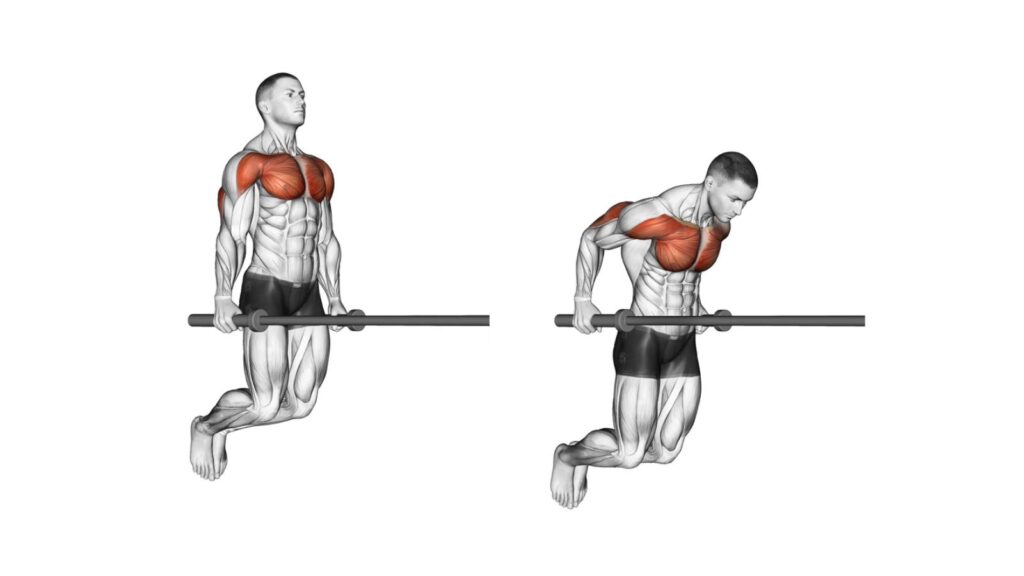
Here’s how to perform chest dips with proper form:
1. Set Up
- Position yourself between the parallel bars or dip bars.
- Stand facing the bars with your feet together.
2. Grip the Bars
- Reach out and grip the bars firmly with your palms facing down (pronated grip).
- Your hands should be slightly wider than shoulder-width apart.
3. Jump or Step Up
- Jump or step up to support your body weight between the bars.
- Your arms should be fully extended, and your body should be centered between the bars.
4. Body Position
- Lean slightly forward with your chest, keeping your torso upright and your core engaged.
- This forward-leaning position emphasizes the chest muscles.
5. Execution
- Slowly lower your body by bending your elbows.
- Lower yourself until your shoulders move slightly in front of your hands, and your chest descends to the level of the bars.
6. Depth and Range of Motion
- Aim to achieve a deep range of motion to maximize chest engagement.
- Your elbows should be bent to approximately 90 degrees, and your chest should descend close to the bars or as low as your flexibility and strength allow.
7. Push Back Up
- Push through your palms and extend your elbows to raise your body back up to the starting position.
- Exhale as you push up.
8. Repeat
- Perform the desired number of repetitions.
- Maintain controlled movements and proper form throughout.
Tips for Safe and Effective Chest Dips:
- Use a spotter if you’re new to chest dips or are lifting heavy weights.
- Keep your chest up and your shoulders back during the exercise to maximize chest engagement.
- Avoid swinging or using momentum to lift your body. Perform the exercise with controlled movements.
- Maintain a slight forward lean in your body position to focus on the chest muscles.
- Ensure that your grip is secure on the bars to prevent slipping.
- As you progress, you can increase the difficulty by adding resistance (e.g., using a dip belt with weights).
Jeff Nippard is a great fitness coach, with some great insights on many exercises. Check out our overview of his diet and workout plan to see how he maintains his incredible physique.
Chest dips can be a challenging exercise, so it’s important to use proper form to prevent injury and achieve the best results.
You can incorporate chest dips into your upper body or chest workout routine to help build strength and definition in the pectoral muscles.
When should you do Chest Dips?
The timing for when to do chest dips depends on your overall workout routine, fitness goals, and personal preferences.
Here are some common scenarios for incorporating chest dips into your training schedule:
- Chest Day: Chest dips are often included as part of a dedicated chest training day. On chest day, you can perform a variety of chest-focused exercises, including bench press, flyes, and chest dips to target the pectoral muscles more effectively.
- Upper Body Split: If you follow a split workout routine that separates upper body and lower body workouts, chest dips can be included in your upper body training day along with other chest and shoulder exercises.
- Strength Training: Chest dips can be included in a strength training routine. You can use heavy weights or additional resistance to build chest strength and size.
- Functional Training: Chest dips can be incorporated into functional training programs aimed at improving upper body strength for daily activities and sports performance.
- Variety and Muscle Imbalance: Chest dips can be a valuable exercise for addressing muscle imbalances or adding variety to your workout routine.
- Accessory Exercise: Chest dips can be used as an accessory exercise to complement primary chest exercises such as the bench press or incline press.
- Calisthenics or Bodyweight Training: If you’re focusing on calisthenics or bodyweight training, chest dips are a challenging bodyweight exercise that can be integrated into your training regimen.
Gradually increase resistance or weights, and incorporate a variety of chest exercises that target different areas of the pectoral muscles.
Benefits of Chest Dips
Chest dips offer a variety of benefits for individuals looking to build strength and develop the pectoral muscles (chest).
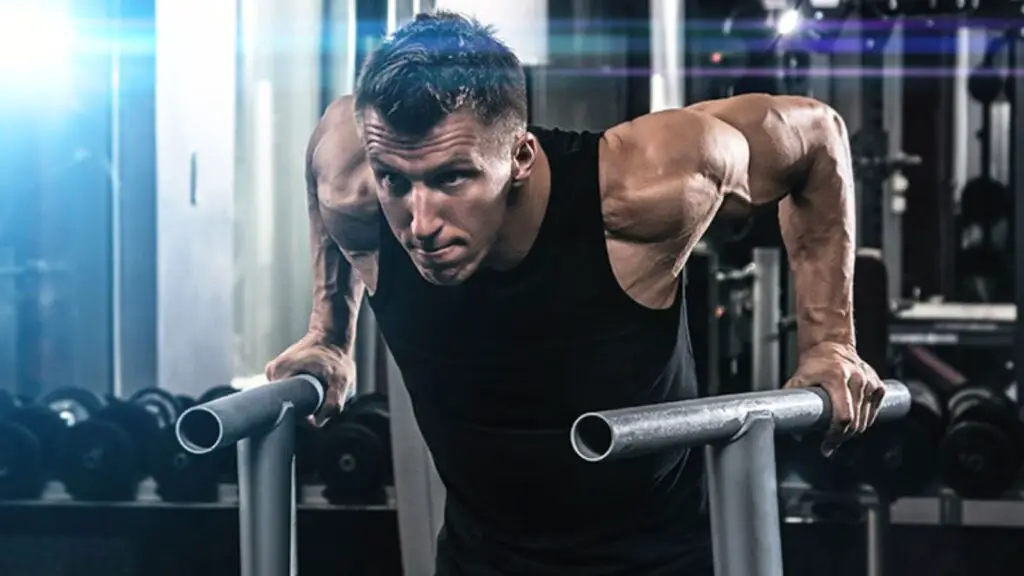
Here are the key benefits of incorporating chest dips into your workout routine:
- Pectoral Muscle Development: Chest dips are a highly effective exercise for targeting and building the pectoral muscles, leading to increased chest strength and muscle size.
- Functional Movement: The movement pattern of chest dips mimics pushing or pressing motions, making it relevant for everyday activities and sports that involve pushing or lifting.
- Upper Body Strength: Chest dips engage not only the chest muscles but also the anterior deltoids (front shoulders) and triceps, contributing to overall upper body strength.
- Variation: Chest dips provide a variation to traditional chest exercises like bench press or push-ups, allowing for a more balanced development of the chest muscles.
- Stability and Balance: To maintain proper form during chest dips, you need to engage your core muscles and maintain stability. This can help improve your overall balance and coordination.
- No Equipment Required: While chest dip bars are ideal, chest dips can be performed with minimal equipment, making them accessible for most people and suitable for bodyweight or calisthenics training.
- Efficiency: Chest dips allow you to work multiple muscle groups in one exercise, which can be time-efficient for full-body or upper body workouts.
- Upper Body Symmetry: Chest dips can help address muscle imbalances between the chest and back, helping to achieve a more symmetrical and well-rounded upper body.
- Progression: As your strength improves, you can increase the difficulty of chest dips by adding weights or changing the angle to emphasize different aspects of chest development.
To get the best out of chest dips, it’s important to perform chest dips with proper form and technique. This includes maintaining a stable and controlled range of motion, and avoiding excessive swinging or using momentum to lift your body.
Chest dips can be a valuable addition to your upper body workout routine, whether you’re focused on building chest strength, improving upper body balance, or seeking variety in your training.
Cons of Chest Dips
Chest dips also come with certain drawbacks and limitations. It’s important to be aware of these cons to ensure safe and effective training.
Here are some of the potential drawbacks of chest dips:
- Difficulty for Beginners: Chest dips can be challenging for beginners, especially if they lack upper body strength or are new to calisthenics-style exercises. Starting with assisted or modified variations may be necessary.
- Risk of Overuse Injuries: Excessive repetition of chest dips without adequate variation or rest can lead to overuse injuries in the shoulder or chest muscles.
- Shoulder Strain: Incorrect form during chest dips, such as allowing the shoulders to roll forward or downward, can lead to strain or discomfort in the shoulder joints.
- Elbow and Wrist Strain: In some cases, individuals may experience strain or discomfort in the elbows or wrists, particularly if they don’t maintain a secure grip on the bars or if they have preexisting issues.
- Need for Spotter: Performing weighted chest dips, especially with significant resistance, can be challenging to do alone. A spotter may be necessary to ensure safety and proper form.
- Potential for Overtraining: Including chest dips in an already intense workout routine may lead to overtraining, which can result in fatigue, decreased performance, and an increased risk of injury.
- Limited Range of Motion for Some Individuals: People with limited flexibility or range of motion in the shoulders or chest may find it challenging to achieve a full range of motion in chest dips.
- Lack of Upper Back Engagement: Chest dips primarily target the pectoral muscles and anterior deltoids, but they do not engage the upper back muscles (e.g., the latissimus dorsi). Therefore, they should be complemented with other exercises to maintain upper body balance.
To mitigate the cons of chest dips and maximize their benefits, consider the following tips:
- Start with assisted or modified variations if you’re a beginner or have limited upper body strength.
- Ensure proper form and technique by keeping your chest up and shoulders back, avoiding rolling forward, and controlling the movement.
- Gradually increase the intensity by adding weight or resistance as your strength improves.
- Include a variety of upper body exercises to ensure balanced muscle development.
Chest dips are great to include in your workout routine but it’s important to use them wisely, with consideration of your fitness level and goals to minimize potential drawbacks.
How to do Tricep Dips?
Tricep dips are a great exercise that can be done anywhere, being highly effective for strengthening the triceps.
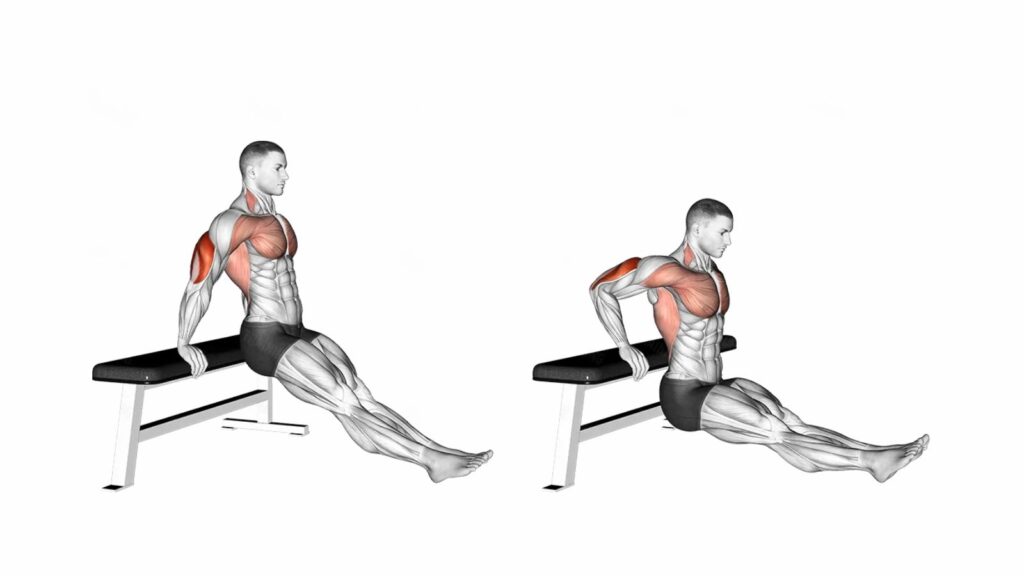
Here’s how to perform tricep dips with proper form:
1. Set Up
- Position yourself between the parallel bars or dip bars.
- Stand facing the bars with your feet together.
2. Grip the Bars
- Reach out and grip the bars firmly with your palms facing down (pronated grip).
- Your hands should be slightly wider than shoulder-width apart.
3. Jump or Step Up
- Jump or step up to support your body weight between the bars.
- Your arms should be fully extended, and your body should be centred between the bars.
4. Body Position
- Keep your torso upright with your chest up and your shoulders back.
- Your elbows should be straight. This position ensures proper form and maximum tricep engagement.
5. Execution
- Slowly lower your body by bending your elbows.
- Lower yourself until your elbows are bent to approximately 90 degrees or slightly less.
- Your shoulders should stay above your hands during the entire range of motion.
6. Depth and Range of Motion
- Aim to achieve a deep range of motion without going so low that it places excessive strain on your shoulders or chest.
- Your focus should be on feeling the contraction in your triceps.
7. Push Back Up
- Push through your palms and extend your elbows to raise your body back up to the starting position.
- Exhale as you push up.
8. Repeat
- Perform the desired number of repetitions.
- Maintain controlled movements and proper form throughout.
Tips for Safe and Effective Tricep Dips:
- Use a spotter if you’re new to tricep dips or are lifting heavy weights.
- Keep your chest up, shoulders back, and elbows close to your body during the exercise to maximize tricep engagement.
- Avoid swinging or using momentum to lift your body. Perform the exercise with controlled movements.
- Ensure that your grip is secure on the bars to prevent slipping.
As you progress, you can increase the difficulty of tricep dips by using additional resistance, such as a dip belt with weights.
When should you do Tricep Dips?
When to do tricep dips can depend on your overall workout routine and fitness goals.
Here are some common scenarios for incorporating tricep dips into your training schedule:
- Arm Day: Tricep dips are often included as part of a dedicated arm training day. On arm day, you can perform a variety of exercises that target the triceps, such as tricep dips, tricep pushdowns, and skull crushers.
- Upper Body Split: If you follow a split workout routine that separates upper body and lower body workouts, tricep dips can be included in your upper body training day, along with other upper body exercises.
- Strength Training: Tricep dips can be part of a strength training routine, where you focus on lifting heavy weights or additional resistance to build tricep strength.
- Functional Training: Tricep dips can be incorporated into functional training programs aimed at improving upper body strength for everyday activities and sports performance.
- Variety and Balance: Tricep dips can provide variety in your workout routine and help balance the development of the upper body muscles.
- Accessory Exercise: Tricep dips can be used as an accessory exercise to complement primary upper body exercises such as bench press, overhead press, or pull-ups.
- Calisthenics or Bodyweight Training: If you’re focused on calisthenics or bodyweight training, tricep dips are a challenging bodyweight exercise that can be integrated into your training regimen.
The timing of when to do tricep dips should align with your individual fitness goals and the structure of your overall workout routine.
Ensure you perform them with proper form, gradually increase resistance or weights as your strength improves. It’s also a great idea to add tricep dips in to your workout as part of a routine with other upper body exercises.
Benefits of Tricep Dips
Tricep dips provide many different benefits when performed correctly. They are a great exercise for tricep development, being highly effective and fairly easy to do.
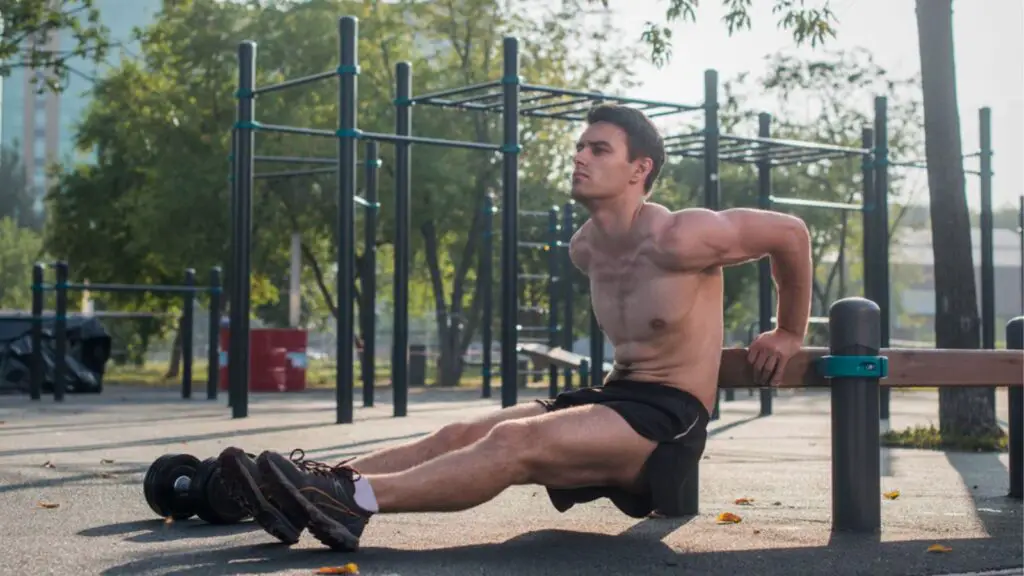
Incorporating tricep dips into your workout routine offers several benefits:
- Tricep Strength: Tricep dips are one of the most effective exercises for isolating and strengthening the triceps. Regular practice can lead to significant improvements in tricep strength.
- Arm Definition: Strengthening the triceps can help define and sculpt the back of your arms, leading to a more toned and aesthetic appearance.
- Upper Body Power: Strong triceps are essential for various upper body movements, including pushing exercises like bench presses, push-ups, and overhead presses.
- Joint Stability: Tricep dips engage the shoulders and elbow joints, which can help improve joint stability when performed with proper form. This can be beneficial for injury prevention and rehabilitation.
- Time Efficiency: Tricep dips are a time-efficient exercise that can be performed as part of an upper body or arm workout to target the triceps specifically.
- Variation: Tricep dips can be modified to increase or decrease the level of difficulty, making them suitable for individuals of different fitness levels.
- Improved Push-Up Performance: Strong triceps can enhance your push-up performance, making it easier to perform more repetitions or progress to more challenging variations.
- Upper Body Coordination: Tricep dips require upper body coordination and stability, which can improve your overall fitness and athletic performance.
- Injury Prevention: Including tricep dips in your workout routine can help prevent overuse injuries in the triceps and shoulders by strengthening the supporting muscles and stabilizing the joints.
To fully benefit from tricep dips, it’s important to perform them with proper form and technique. This includes maintaining an upright body position, keeping your elbows close to your body, and avoiding excessive swinging or momentum.
Cons of Tricep Dips
Tricep dips can come with certain drawbacks and limitations. It’s important to be aware of these cons to ensure safe and effective training.
Here are some potential drawbacks of tricep dips:
- Shoulder Strain: Tricep dips can place significant stress on the shoulders, particularly if you allow your shoulders to roll forward or downward during the exercise. This can lead to shoulder strain or discomfort.
- Elbow and Wrist Strain: Some individuals may experience strain or discomfort in the elbows or wrists, especially if they don’t maintain a secure grip on the bars or have pre-existing issues in these areas.
- Lack of Upper Back Engagement: Tricep dips primarily target the triceps and the shoulders, but they do not engage the upper back muscles (e.g., the latissimus dorsi). Therefore, they should be complemented with other exercises to maintain upper body balance.
- Injury Risk: Incorrect form, such as allowing the shoulders to roll forward or downward, can increase the risk of injury, particularly to the shoulders or elbows. It’s important to use proper form and technique.
- Equipment Availability: Tricep dip bars may not be readily available in all gym or workout environments, which could limit exercise options.
- Potential for Overtraining: Including tricep dips in an already intense workout routine may lead to overtraining, which can result in fatigue, decreased performance, and an increased risk of injury.
To mitigate the cons of tricep dips and maximize their benefits, consider the following tips:
- Use a spotter if you’re new to tricep dips or are lifting heavy weights.
- Keep your chest up, shoulders back, and elbows close to your body during the exercise to maximize tricep engagement.
- Avoid swinging or using momentum to lift your body. Perform the exercise with controlled movements.
- Ensure that your grip is secure on the bars to prevent slipping.
Tricep dips can be a valuable addition to your upper body workout routine, but it’s important to use them wisely, with consideration of your fitness level and goals, and with proper form to minimize the potential drawbacks.
FAQs
Can chest dips and tricep dips be done using different equipment?
Yes, both exercises can be performed using different equipment. The choice of equipment depends on what is available to you and your personal preference.
Chest dips can be done using parallel bars, dip stations, or even a sturdy set of parallel handles.
Tricep dips can also be performed using parallel bars, dip stations, or even a stable bench or chair.
What other exercises can I do with chest dips?
There are many different exercises that compliment chest dips, including the tricep dips. It just depends on what muscle you want to target. Chest dips can be a great exercise to end your chest workout or even as a warm up depending on your fitness level.
Check out our article on Bench Press vs Push Ups to get a better understanding of other chest workouts that can be included with chest dips.
Are chest dips and tricep dips suitable for beginners?
While chest dips and tricep dips can be challenging exercises, they can be modified to accommodate beginners.
Start with assisted variations using resistance bands or assisted dip machines to build strength gradually. It is essential to focus on proper form and technique to avoid strain or injury.
How often should I add these exercises in my workout routine?
Aim for 2-3 sessions per week, allowing adequate rest and recovery between workouts. It is important to listen to your body and adjust the frequency based on your individual needs and recovery capacity.

